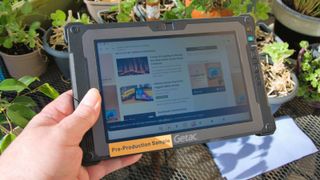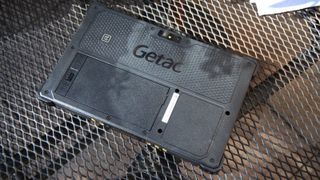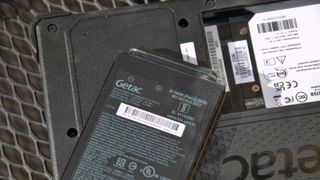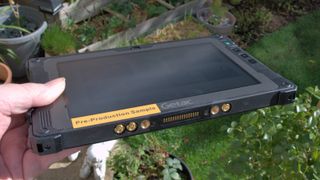Getac
ZX80:
30-second
review
Getac
has
built
a
good
reputation
for
making
laptops
ideal
for
challenging
environments
that
have
excellent
accessories
and
come
with
specialist
service
contracts.
These
devices
are
mostly
based
on
Intel
silicon,
but
the
ZX80
(no,
not
that
ZX80)
tablet
is
something
of
a
departure
from
the
norm
for
this
hardware
maker.
The
ZX80
is
an
8-inch
Android
tablet,
but
sporting
all
the
typical
design
choices
that
a
laptop
from
this
brand
comes
with.
Those
include
a
robust
polycarbonate
shell,
water-resistant
ports,
specialist
connectors
for
vehicle
or
workspace
mounting,
and
modular
features
to
add
specific
functionality.
The
review
model
came
with
a
module
for
barcode
scanning,
demonstrating
that
this
hardware
would
be
at
home
in
a
warehouse,
but
other
modules
can
be
mounted
with
various
capabilities.
Its
design
differs
even
more
significantly
from
typical
rugged
Android
tablets
in
that
it
has
two
batteries,
one
of
which
can
be
hot-swapped
out,
enabling
it
to
remain
operational
for
prolonged
periods.
As
we’ll
cover
in
the
review,
the
ARM
SoC
at
the
heart
of
the
ZX80
is
much
more
potent
than
a
typical
Android
tablet
might
receive.
Conversely,
the
inbuilt
cameras
are
lower
specification
than
even
entry-level
phones
get
these
days.
This
feature
set
makes
the
ZX80
highly
suitable
for
certain
roles
in
the
manufacturing
and
logistics
sectors
but
not
ideal
for
those
where
high-quality
photography
might
be
a
requirement.
Those
who
might
consider
a
device
like
this
have
one
final
hurdle
to
clear:
the
disturbingly
high
price
of
the
machine
and
its
accessories.
A
typical
rugged
Android
tablet
costs
between
$200-300,
and
even
premium
devices
topping
out
at
$500-600.
Getac
wants
around
$1500
for
the
machine
and
equally
elevated
prices
for
the
extra
batteries
and
other
accessories.
However,
exact
prices
can
vary
since
this
is
a
solution
where
you
contact
a
reseller
and
ask
for
a
quote.
Getac
ZX80:
Price
and
availability

(Image
credit:
Mark
Pickavance)
-
How
much
does
it
cost? From
around
£1,300 -
When
is
it
out? Available
now -
Where
can
you
get
it? From
a
Getac
reseller
Unlike
most
tablets
we
cover
here,
the
Getac
ZX80
doesn’t
have
a
quotable
cost
since
each
device
is
customised
specifically
for
that
customer.
A
machine
like
the
review
hardware
will
likely
cost
more
than
$1500,
but
without
any
accessories,
a
service
contract,
or
enhancements.
Various
sensor
options,
cradles,
more
batteries,
and
external
chargers
can
significantly
increase
that
number.
If
your
accounts
department
gets
nervous
at
Apple
iPad
prices,
it
might
need
some
preparation
for
an
investment
in
this
equipment.
Getac
ZX80:
Specs
to
scroll
horizontally
| Item | Spec |
|---|---|
| Hardware: |
Getac ZX80 G1 |
| CPU: |
Qualcomm sm7325 |
| GPU: |
Adreno 643 |
| NPU: |
Qualcomm Hexagon Processor |
| RAM: | 8GB |
| Storage: | 180GB |
| Screen: |
8-inch TFT LCD 1000 nits |
| Resolution: |
1200 x 1920 FHD+ |
| SIM: |
Dual Nano SIM + MicroSD option |
| Weight: |
590g (1.3lbs) |
| Dimensions: |
234 x 149.8 x 17.6mm (9.21″ x 5.89″ x 0.69″) |
|
Rugged Spec: |
IP67 and MIL-STD-810H |
|
Rear cameras: |
16.3MP Samsung GN1 Sensor |
|
Front camera: |
8MP Samsung GD1 |
| Networking: |
WiFi 6, Bluetooth 5.2 |
| OS: |
Android 13 |
| Battery: |
4060mAh internal, 4990mAh swappable |
Getac
ZX80:
Design

(Image
credit:
Mark
Pickavance)
-
Sturdy
built -
Unusual
layout -
High
brightness
screen
When
picked
up
for
the
first
time,
the
ZX80
exudes
solidity
with
what
appears
to
be
a
glass-reinforced
plastic
case
and
bold
impact-resistant
corners.
At
just
590g,
it’s
also
much
lighter
than
expected,
given
that
this
design
has
two
batteries.
Instead
of
the
typical
edge
buttons,
Getac
went
with
an
alternative
approach
where
all
the
buttons
are
on
the
face
of
the
tablet,
although
they
are
so
small
that
it
hints
this
machine
was
made
specifically
to
use
a
stylus.
The
power
button
is
only
a
few
millimetres
across,
and
pressing
it
with
the
tip
of
a
finger
isn’t
straightforward.
Each
side
of
the
ZX80
has
a
purpose,
with
the
exception
of
the
right,
which
has
no
ports
or
capabilities.
The
bottom
edge
has
various
connectors
for
a
docking
station.
The
left
has
a
USB-C
port
and
an
audio
jack,
covered
with
a
locking
weatherproof
cover.
The
top
edge
of
the
review
hardware
has
a
barcode
reader,
but
from
what
we
understand,
this
feature
is
modular.
The
back
has
a
catch
system
for
removing
one
of
the
batteries,
and
the
SIM
tray
is
hidden
inside
that
battery
pocket.
This
machine
can
take
one
5G
SIM
and
a
MicroSD
card,
but
changing
either
requires
the
removal
of
the
battery.

(Image
credit:
Mark
Pickavance)
Most
rugged
tablets
are
larger
than
this
one,
and
there
is
a
good
reason
why.
The
8-inch
corner-to-corner
display
is
exceptionally
bright,
with
a
quoted
brightness
of
1000
nits
and
an
anti-reflection
coating.
That
specification
should
make
the
screen
suitable
for
UAV
use,
although
the
coating
tends
to
soften
the
image
in
a
way
that
most
drone
pilots
wouldn’t
appreciate
when
trying
to
detect
thin
obstructions,
such
as
wires.
Given
that
most
drones
now
come
with
dedicated
Android
controllers
with
an
in-built
display
or
larger
than
8-inch
screens,
the
ZX80
might
not
sell
well
to
the
professional
UAV
crowd.
The
biggest
issue
with
the
screen
is
that
using
it
with
fingers
isn’t
elegant,
even
if
it
has
settings
for
fingers,
gloves
or
a
stylus.
The
icons
are
just
too
small,
and
using
the
on-screen
keyboard
is
a
trial-and-error
exercise.
The
ZX80
should
have
had
an
inbuilt
stylus
out
of
the
box
and
not
one
you
must
purchase
as
an
optional
accessory.
Getac
ZX80:
Hardware
-
Powerhouse -
Limited
battery
capacity
The
best
aspect
of
the
ZX80
is
the
SoC
that
Getac
used.
That
statement
assumes
that
the
retail
version
of
the
ZX80
will
have
the
same
SoC
as
the
pre-production
sample.
There
are
no
guarantees,
and
the
Getac
website
describes
the
ZX80
as
having
8GB
of
RAM
and
256GB
of
storage,
whereas
the
sample
we
used
only
had
6GB
and
180GB,
respectively.
If
Getac
sticks
with
the
Qualcomm
sm7325,
aka
the
Snapdragon
778G
5G
Mobile
Platform,
this
is
easily
the
most
powerful
rugged
Android
tablet
we’ve
ever
tested.
This
chip
has
seen
service
in
the
Samsung
Galaxy
Tab
Active4
Pro,
which
was
launched
in
2022.
The
downside
of
such
an
impressive
chip
is
that
this
tablet
consumes
the
contents
of
its
dual
batteries
at
a
gallop.
Capacity
is
split
between
the
4060mAh
internal
and
unswappable
module
and
a
4990mAh
swappable
battery,
the
default
option.
A
bigger
swappable
high-capacity
battery,
9980mAh,
can
be
specified,
larger
than
the
total
capacity
of
the
sample
machine.
The
default
battery
and
internal
source
provide
enough
power
for
a
working
day,
but
forgetting
to
recharge
could
be
a
big
problem
for
those
on
a
later
shift.
We
should
also
mention
that
the
hardware
we
received,
marked
as
a
‘Pre-production
Sample’,
exhibited
a
few
less-than-ideal
power
management
issues.
In
short,
with
the
tablet
asleep,
its
entire
battery
capacity
would
leak
away
over
about
two
days,
with
no
indication
in
the
battery
use
panels
as
to
where
that
power
went.
That’s
not
ideal,
especially
if
someone
forgets
to
charge
the
tablet
at
the
end
of
a
working
day.
We
can
only
hope
that
whatever
the
problem
might
be,
it
is
resolved
in
retail
production
models.

(Image
credit:
Mark
Pickavance)
Getac
ZX80:
Cameras
-
16.3MP
sensor
on
the
rear -
8MP
on
the
front -
Two
cameras
in
total
Someone
in
the
technical
department
of
Getac
decided
that
photo
taking
wasn’t
important
and
gave
the
ZX80
two
sensors
that
probably
wouldn’t
be
good
enough
for
a
budget
phone.
And,
the
specifications
don’t
say
what
the
sensors
are,
with
the
Android
distro
having
been
compiled
with
a
wide
selection
of
options,
many
being
a
much
higher
resolution
than
the
two
used.
It’s
an
educated
guess,
but
the
rear
sensor
is
probably
an
Omnivsion
ov16a10,
and
the
front
sensor
is
an
Omnivsion
ov8856.
The
one
redeeming
feature
of
the
rear
sensor
is
that
it
records
4K
video
at
30
fps,
although
there
are
no
frame
rate
controls
at
the
resolution.
But
for
still
image
control,
you
get
a
resolution
selection
and
a
digital
zoom.
That’s
about
it.
There
are
no
special
shooting
modes
and
no
‘Pro’
option
for
manual
settings.
We’ve
complained
plenty
about
Chinese
mainstream
brands
not
exploiting
the
sensors
they
include,
but
at
least
these
put
a
few
photography
and
video
options
on
their
devices.
We’ve
included
a
selection
of
images
taken
on
the
ZX80,
and
the
results
are
generally
crisp,
but
the
software
is
poor
at
deciding
where
in
the
scene
to
focus
without
encouragement
and
is
equally
woolly
about
adjusting
brightness
in
a
balanced
way.
With
this
hardware,
you
can
take
some
decent
images,
but
it’s
more
about
luck
than
intention.
Getac
ZX80:
Performance
to
scroll
horizontally
| Tablet |
Header Cell – Column 1 |
Getac ZX80 |
Ulefone Armor Pad 2 |
|---|---|---|---|
| SoC |
Row 0 – Cell 1 |
Snapdragon 778G 5G |
MediaTek Helio G99 |
| Mem |
Row 1 – Cell 1 | 8GB/180GB | 8GB/256GB |
| Geekbench | Single | 1137 | 544 |
|
Row 3 – Cell 0 | Multi | 3056 | 1811 |
|
Row 4 – Cell 0 | OpenCL | 2891 | 1481 |
|
Row 5 – Cell 0 | Vulkan | 3159 | 1528 |
| GFX |
Aztec Open Normal | 44 | 15 |
|
Row 7 – Cell 0 |
Aztec Vulkan Normal | 49 | 13 |
|
Row 8 – Cell 0 |
Car Chase | 41 | 14 |
|
Row 9 – Cell 0 |
Manhattan 3.1 | 59 | 24 |
| PCMark |
3.0 Score | 9521 | 10451 |
|
Row 11 – Cell 0 | Battery |
15h 24m |
26h 17m |
|
Charge 30 mins | % | 18% | 20% |
| Passmark | Score | 15029 | 9786 |
|
Row 14 – Cell 0 | CPU | 7097 | 4655 |
| 3DMark |
Slingshot OGL | 7781 | 3508 |
|
Row 16 – Cell 0 |
Slingshot Ex. OGL | Maxed | 2625 |
|
Row 17 – Cell 0 |
Slingshot Ex. Vulkan | Maxed | 2474 |
|
Row 18 – Cell 0 | Wildlife | 3411 | 1219 |
For
comparison,
we
placed
the
Getac
ZX80
up
against
the
Ulefone
Armor
Pad
2,
a
device
that
is
about
30%
of
its
cost.
And,
given
that
the
Ulefone
device
is
so
much
cheaper
and
not
designed
for
the
same
market
slice,
its
performance
is
predictably
much
less
than
the
Snapdragon-powered
ZX80.
It
truly
shines
when
the
Adreno
643
GPU
kicks
into
high
gear,
and
in
a
few
of
the
3DMark
tests,
it
was
so
fast
the
benchmarks
aborted
with
‘Maxed
Out’
being
reported.
That
is
part
of
the
results
we
expected,
but
the
battery
life
of
the
Getac
isn’t
wonderful,
even
with
two
batteries.
However,
this
isn’t
an
apples-to-apples
comparison
since
the
Pad
2
has
an
18600mAh
battery,
while
the
combined
battery
capacity
of
the
ZX80
is
only
9050mAh.
If
the
ZX80
had
the
same
18600mAh
capacity,
based
on
what
it
achieves
with
9050mAh,
it
would
probably
last
for
more
than
30
hours.
If
this
device
is
used
for
multiple
shifts
and
is
not
being
charged
in
its
dock,
does
it
have
enough
battery
power
to
cope?
The
answer
is
‘no’,
but
it
has
the
hot-swappable
battery
to
help
mitigate
that
problem
if
the
budget
can
cope
with
the
high
cost
of
the
batteries
and
the
separate
charger
needed
to
recharge
them
away
from
the
tablet.

(Image
credit:
Mark
Pickavance)
Getac
ZX80:
Verdict
There
are
some
great
things
about
this
tablet,
including
the
Snapdragon
processor
and
the
modular
add-ons.
It’s
also
nice
to
see
a
replaceable
battery,
although
only
one
is
replaceable,
which
begs
the
question
of
what
happens
when
the
internally
mounted
one
starts
to
wear
out.
For
whatever
reason,
Getac
decided
that
its
core
market
for
the
ZX80
wanted
some
things
and
not
others,
which
explains
why
the
cameras
are
so
poor.
But
frankly,
if
you’ve
spent
this
much
on
a
tablet,
you
have
a
right
to
expect
better
sensors
than
the
ones
the
ZX80
got
saddled
with.
But
the
elephant
in
this
room,
a
somewhat
constant
companion
for
Getac,
is
the
cost
of
an
Android
tablet
when
the
marketing
hype
is
stripped
away.
It’s
a
special
one,
but
not
so
unique
that
it
justifies
these
price
points
we’d
contest.
The
cost
might
not
be
an
issue
for
corporate
customers
who
might
write
off
these
purchases
against
budgets
and
tax
deductions
if
they
fulfil
their
purpose.
But,
any
business
involved
in
cost
cutting
might
be
advised
to
consider
less
ambitious
devices.
